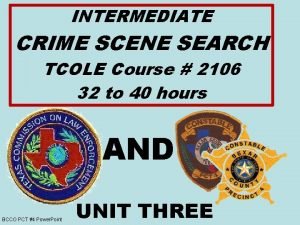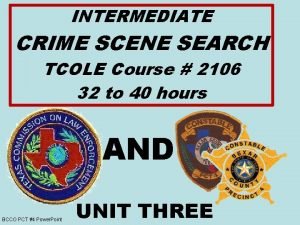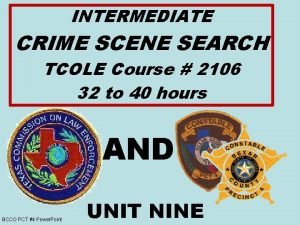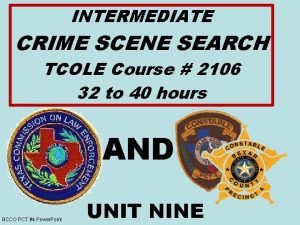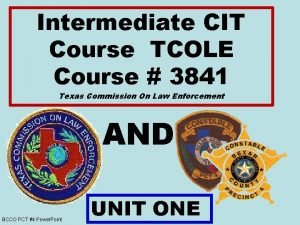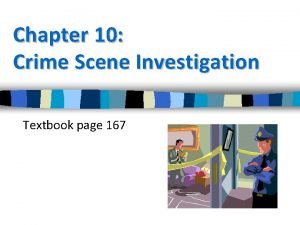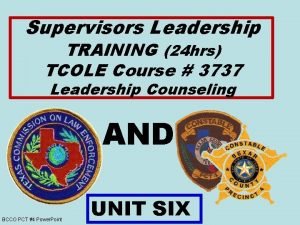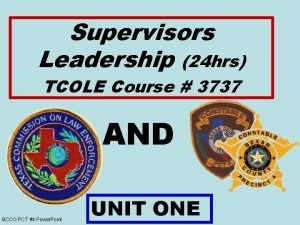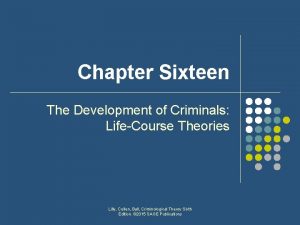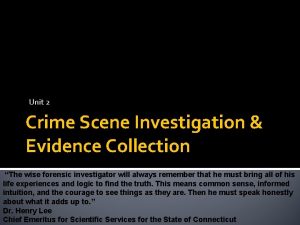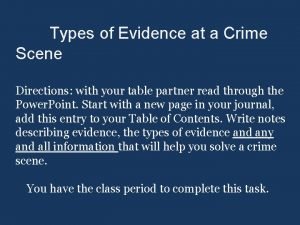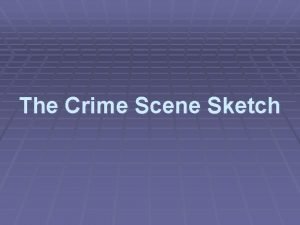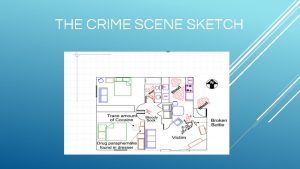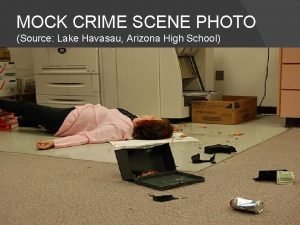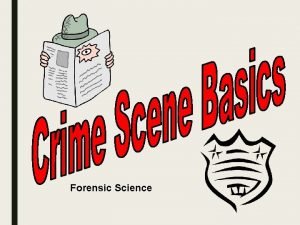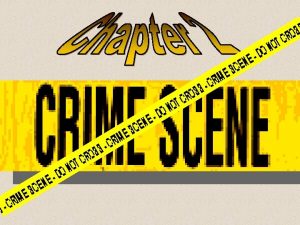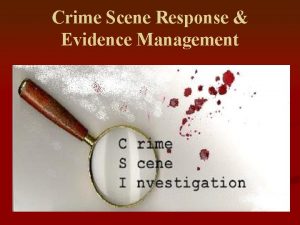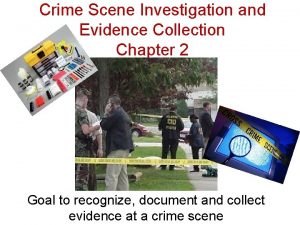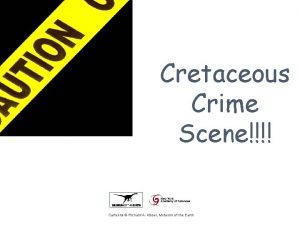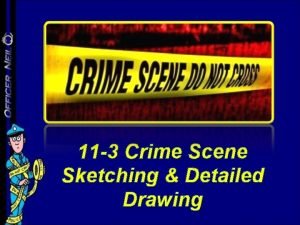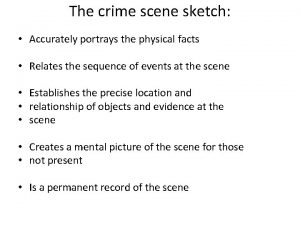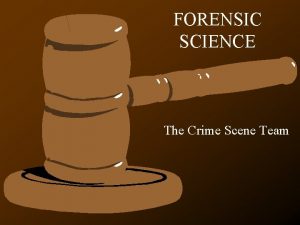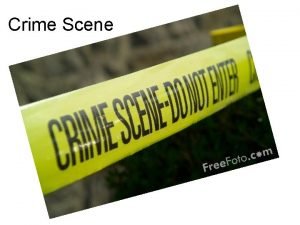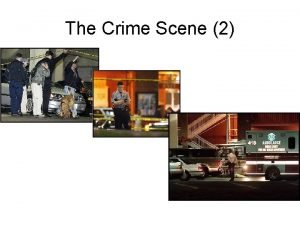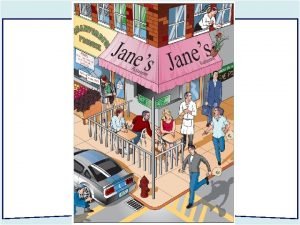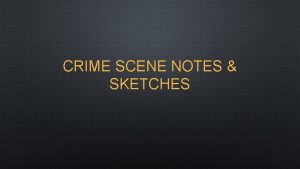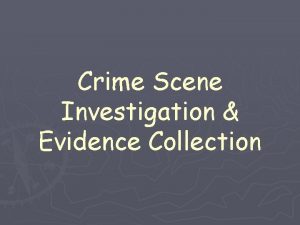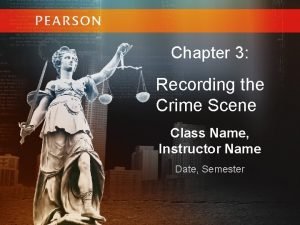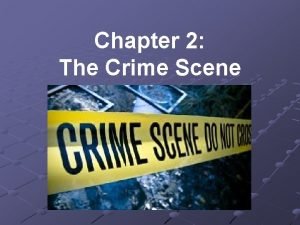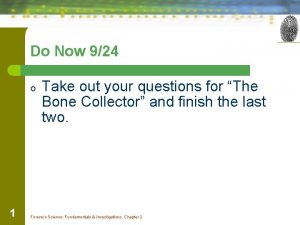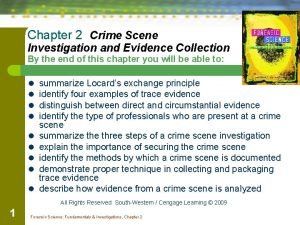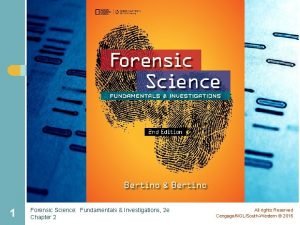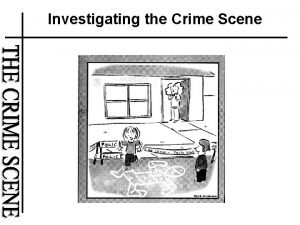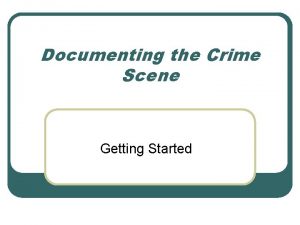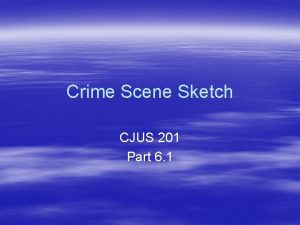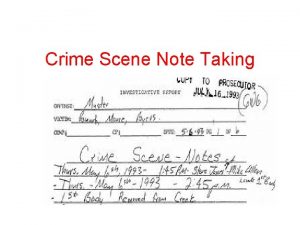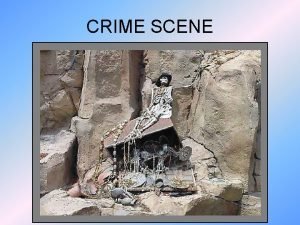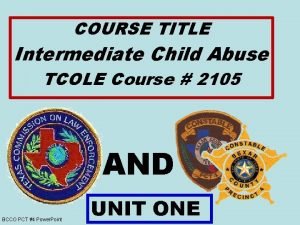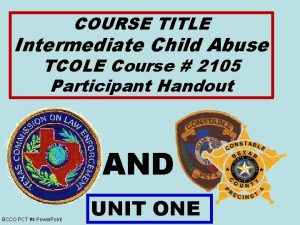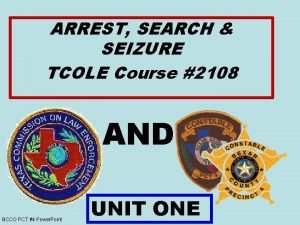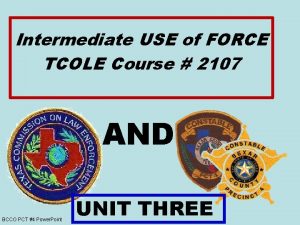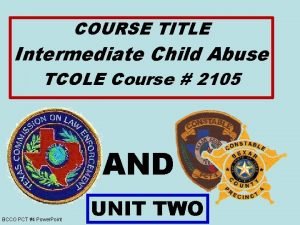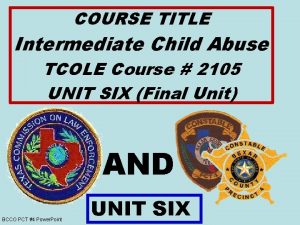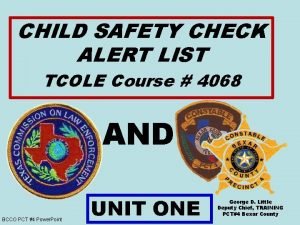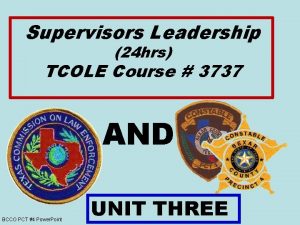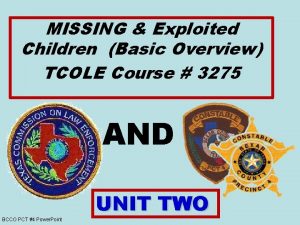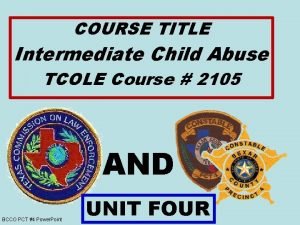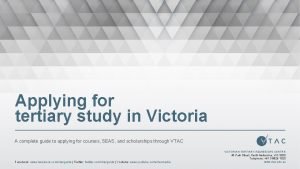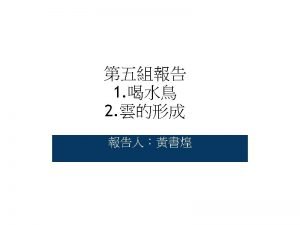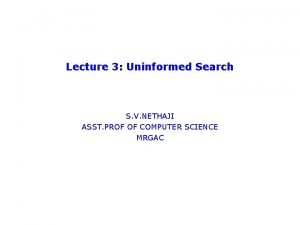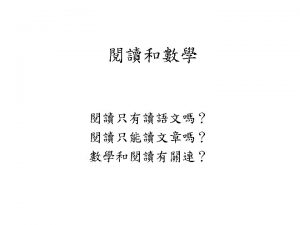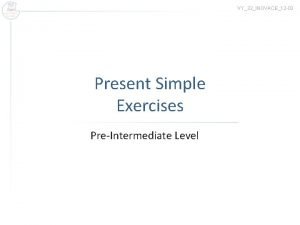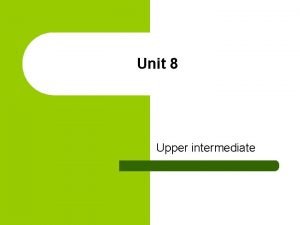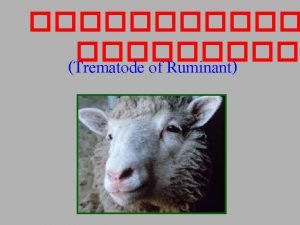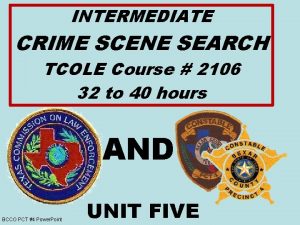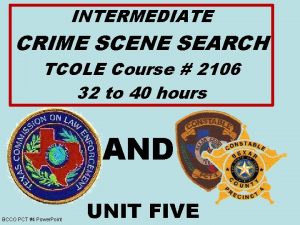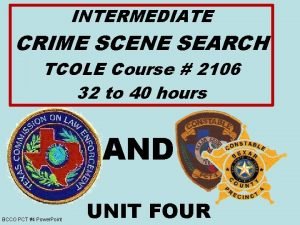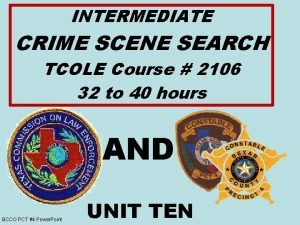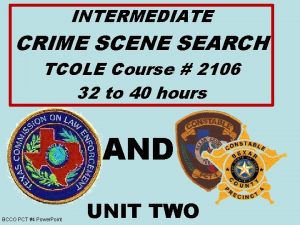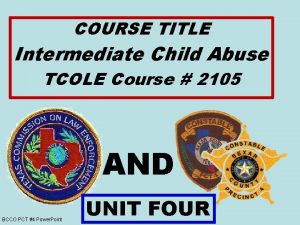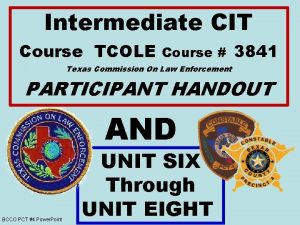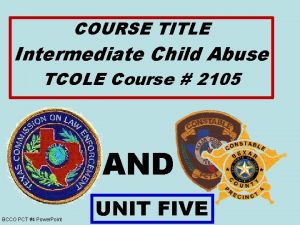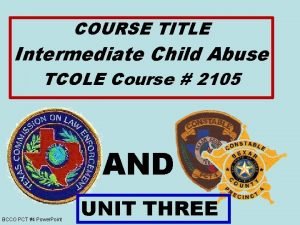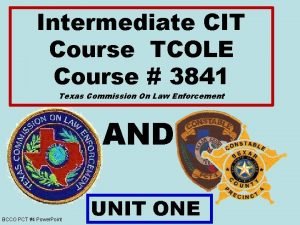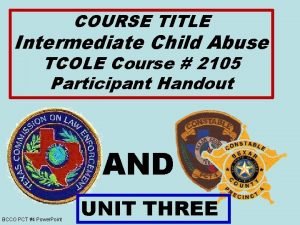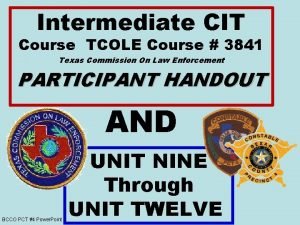INTERMEDIATE CRIME SCENE SEARCH TCOLE Course 2106 32












































































































- Slides: 108

INTERMEDIATE CRIME SCENE SEARCH TCOLE Course # 2106 32 to 40 hours AND BCCO PCT #4 Power. Point UNIT FIVE

Learning Objectives Learning Objective 5. 1. 1 The student will be able to explain the value of fingerprints as physical evidence. Learning Objective 5. 1. 2 The student will be able to identify the methods of classifying fingerprints. Learning Objective 5. 1. 3 The student will be able to identify the methods for identifying fingerprints. Learning Objective 5. 1. 4 The student will be able to describe the differences between "visible", "plastic", and "latent" impressions. Learning Objective 5. 1. 5 The student will be able to explain the process of producing latent impressions.

Learning Objective 5. 1. 6 The student will be able to name the different types of methods for developing latent impressions. Learning Objective 5. 1. 7 The student will be able to understand the use of computerized fingerprinting, known as the AFIS system. Learning Objective 5. 1. 8 The student will be able to explain the methods of rolling a full set of legible fingerprints on a standard DPS/FBI fingerprint card. Learning Objective 5. 1. 9 The student will be able to demonstrate how to produce fingerprint evidence during a crime scene search.

5. 0 Fingerprinting

5. 1. 1 Fingerprints as Physical Evidence A. Fingerprints as evidence 1. Relate ____ to the ultimate objective of every criminal investigation, the ______ identification of the _______. 2. Prove person's ____ at crime scene.

Continued: 5. 1. 1 A. Fingerprints as evidence 3. Frequently present at a crime Frequently scene.

5. 1. 2 Methods for classifying fingerprints 1. A fingerprint classification is a _______ given to all ten fingers on a fingerprint card based on a pattern type, ridge count, or ridge tracing. Anything less cannot be classified and searched.

Continued: 2. The fingerprint classification could be referred to as the ____ by which fingerprint cards are filed where, at some future time, they can be located. 5. 1. 2

Continued: 5. 1. 2 3. The only patterns usually used to define pattern areas for classification purposes are _____ and ______. The pattern area consists of the part of a loop or whorl in which appear the cores, deltas, and ridges with which is the focus when classifying.

Fingerprint Patterns 5. 1. 2

Continued: 5. 1. 2 4. Despite such factors as aging and a variety of environmental influences, a person's fingerprints have never been known to change. The unchanging pattern thus provides a permanent record of the individual throughout life.

5. 1. 3 Fingerprint Identification A. Fingerprint identification.

1. Scientific basis of fingerprint identification 5. 1. 3 a. Based on distinctive ridge outlines that appear on the bulks on the inside of the end joints of the fingers and thumbs.

Continued: 5. 1. 3 b. The ridge outlines have definite ____ and appear in several general pattern types. Each type has general and specific variations of the pattern, depending on the shape and relationship of the ridges. c. The ______ arrangement on every finger of every person is different.

Continued: 5. 1. 3 d. The ridge arrangement is permanent throughout the person's life; that is, the ridge arrangement never changes from birth to death. never

Continued: 5. 1. 3 e. These statements are true also of the ____ on the palms of the hands and the soles of the feet. Identifications in those areas have the same technical and legal validity as fingerprints.

Continued: 5. 1. 3 B. An identification is made by comparing the ____ details in two prints to determine whether or not they match

5. 1. 3 C. Types of patterns. 1. Fingerprints may be resolved into three large general groups of patterns: the ____, and the _____. Each group bears the same general characteristics. 2. _______ can be further subdivided by means of the smaller differences existing between patterns in the same general group

5. 1. 3 C. Types of patterns. 3. Patterns are divided as follows: a. ____ loop. b. _____. c. Plain ______. d. Plain ______. e. _____. f. Accidental ______. g. Central ______.

Continued: 5. 1. 3 D. Identification points are as follows: 1. ______ - ridge forks and becomes two or more ridges. 2. ______ ridge - ridge makes a sudden stop. 3. Ridge ______ – ridge bifurcates and then forks into a ridge. 4. ___ - self-explanatory.

Continued: 5. 1. 3 D. Identification points are as follows: 5. _____ ridge – no longer than the width of the corresponding ridges. 6. _____ - spreading apart of two ridges that have been running parallel or nearly parallel.

Continued: 5. 1. 3 E. There is no specific number of specific comparison points required for a positive ID. F. Only enough points are necessary to form an _______ in the mind of the expert who is making the comparison.

5. 1. 4 Difference between visible, plastic and latent fingerprint impressions A. Visible impressions (dust prints). 1. Print that has been ____ with foreign matter.

5. 1. 4 A. Continued: 2. If a finger is placed in a thin layer of dust, the dust may cover the ____ ridges. If the finger subsequently touches a clean surface, a visible fingerprint may result.

5. 1. 4 A. Continued: 3. A _______ fingerprint may also fingerprint develop as a result of touching other substances such as blood, wood, flour, ink or oil.

5. 1. 4 A. Continued: 4. Impressions are usually _______ and _______ without the use of additional light. 5. Should be a _______ sign to an sign officer that there are probably some good prints available.

Continued: 5. 1. 4 B. Plastic impressions. 1. The result of the fingers being _______ into a soft substance, such as putty, wet paint, soap, grease, tar or wax, and are visually distinct. 2. They are also found on recently _______ surfaces, in the gum on stamps or envelopes, and on adhesive tapes.

5. 1. 4 C. Latent Impressions (patent fingerprint). Continued: 1. Occurs when the entire pattern of ______ on the finger, which contain small amounts of grease, oil, perspiration, or dirt, is transferred to an object when it is touched.

C. Latent Impressions. Continued: 5. 1. 4 2. The ______ and ____ are usually neutral and are transferred to the transferred finger when the person touches other finger areas of his or her body containing various bodily excretions 3. Latent prints are usually not visible (“hidden”) to the _____ and require the use of special techniques and equipment in order to examine properly.

Continued: 5. 1. 4 C. Latent Impressions 4. Is a reproduction of the ______ of fingers, soles of the fingers palms, palms toes, or toes soles feet on any surface touched. feet

5. 1. 5 Producing Latent Print Impressions A. Techniques for locating latent A. impressions. 1. The beam from a flashlight held 1. at an _____ with a surface may reveal impressions that are impressions not otherwise visible.

Continued: 5. 1. 5 A. Techniques for locating latent A. impressions. Continued: 2. The examination of a surface 2. examination from different ______ may produce a similar effect. 3. _____ on a surface may 3. cause _____ to be visible on certain types of materials.

Continued: 5. 1. 5 B. Conditions which affect latent impressions. 1. The quality of ______ impressions quality is affected by such conditions as: a. The manner in which the ______ was transferred. b. The ______ and ____ of the substance (perspiration, oils, blood, and other), which cover the ridge surfaces.

Continued: 5. 1. 5 B. 1. c. Weather conditions. d. Any ____ or ______ defects of the person transferring the print.

Continued: 5. 1. 5 B. 1. e. Occasionally, wet items, such as beer cans or glasses that have ______ on the outside of them, or automobiles which have been covered with dew, must be dew processed for prints.

Continued: 5. 1. 5 B. 1. e. (1) These items should first be allowed to ___ under natural conditions in a sheltered area. (2) Under no circumstances should _______or artificial heat of any kind be used to ____ heat an object.

5. 1. 5 C. Prints at the crime scene. 1. Preventing contamination 1. a. _______ all _____, as best you can, where you think the criminal has had his hands and feet. b. Let the ______ decide whether or not there are latent prints on the objects touched.

Continued: 5. 1. 5 C. 1. c. Only the latent print examiner should handle the object. d. Any surface, that has been surface _______, is a potential place to lift latent impressions. 2. Points of entry and exit should be 2. entry exit carefully examined.

Continued: 5. 1. 5 C. 2. Points of entry and exit should be carefully examined. 3. The ___ __ ______and _____ may interfere with physical and chemical analysis, particularly in the case of blood, fabrics, and documents

Continued: 5. 1. 5 C. 4. In cases involving items with material adhering to their surfaces and/or which will require further laboratory examinations, _____ processing should not be not _____ at the crime scene

Continued: 5. 1. 5 C. 5. Rather, the items should be submitted to a _____ where they can be processed for fingerprints in conjunction with other examinations that have to be undertaken.

Continued: 5. 1. 5 D. Dusting latent impressions 1. ______ is recommended for the development of latent impressions on a hard, dry, and smooth surface. 2. The purpose of dusting or "developing" a latent impression is to ____ __ _______ so it may be preserved and compared.

Continued: 5. 1. 5 D. Dusting latent impressions 3. No attempt should be made to _____ or _____ powder to prints in dust, obviously greasy prints or bloody prints, as this will usually destroy them. This type of impression should be photographed

Continued: 5. 1. 5 D. Dusting latent impressions 4. Before developing the print, the fingerprint brush should be cleaned and the bristles _____ by rolling the handle rapidly between the palms of the hands and letting the bristles spread out naturally. 5. A gray ______ should be used on dark-colored surfaces, mirrors, and polished metal surfaces.

Continued: 5. 1. 5 D. Dusting latent impressions 6. A _____ powder should be applied to white or light colored surfaces. 7. _____ or ____ powder can be used on clear transparent glass. transparent 8. Other colors of ______ used, but black or gray are the most common.

Continued: 5. 1. 5 E. Application of powder. 1. Avoid _____ and haphazard techniques. 2. A ______is needed. 3. Powder should be used ____ 4. Distribute the powder _______ across the fingerprint until the characteristic outlines of the ridge become visible. .

Continued: 5. 1. 5 E. 4. a. Care should be taken to brush the latent print with the ____ of the ____ by using short, short quick strokes 5. After the latent has become visible, it should be “_______" by ______ brushing away all of the excess powder adhering between the ridges.

Continued: 5. 1. 5 5. a. This step is extremely important because _______may destroy the clarity of the ridge detail destroy ridge and render it useless for identification purposes. b. In some cases, it is not possible to remove the ______ by means of a brush. .

Continued: 5. 1. 5 5. c. When this condition occurs, an attempt should be made to ______ the excess powder with lifting tape. d. The latent remaining on the object will be sufficiently _____ and ______ to permit identification.

5. 1. 5 F. Lifting latent impressions 1. Prints should be ______ before they are lifted. a. The use of a fingerprint camera, which photographs ___-to-___ (exact size), is the most ideal. b. A small tab of _____ on which is inscribed appropriate identifying data, should be placed in the field of view in a manner that will insure its inclusion in the photograph.

F. Lifting latent impressions 5. 1. 5 2. The lifting of prints is most usually accomplished by using ______ lifting tape. 3. Method for lifting impressions. a. Use lifting tape _____ enough to cover the entire latent impressions. b. Press the _____ side of the plate against the powdered impression(s), carefully avoiding the production of air

Continued: 5. 1. 5 F. Lifting latent impressions 3. Method for lifting impressions. c. Insure completed ____ by rubbing the entire surface starting in the center and working toward the edges. d. Beginning at one ____ or _____, peel the tape gently from the surface and place on a _ x _ card

Continued: 5. 1. 5 F. Lifting latent impressions 3. d. Beginning at one edge or corner, peel the tape gently from the _______ and place on a 3 x 5 ____. e. Identifying ____ can be written on the 3 x 5 card to indicate the location, date, case number, examiner's name, or any other pertinent information.

5. 1. 6 Types/Methods for developing latent impressions A. Chemical development of latent impressions 1. Used to develop latent ______ impressions on paper, cardboard, unpainted wood, or other absorbent surfaces.

Continued: 5. 1. 6 A. 2. Three chemicals commonly used: a. ______. b. _____. c. _______.

Continued: 5. 1. 6 3. Each of the chemicals _____ with a different _____, which may be present in the latent print. 4. Sometimes, it may be desirable to use all _____ processes.

Continued: 5. 1. 6 5. The sequence used must be: (1) ______, (2) _____, (3) silver nitrate. 6. ______ is another chemical used, which is found in _____.

5. 1. 6 B. Types of chemical methods used in developing latent impressions. 1. Iodine method a. Iodine crystals when exposed to slight ____ will vaporize, producing violet fumes. b. , The _____ and _____ naturally produced by the skin discolor very easily and naturally become a good candidate for development with iodine

Continued: 5. 1. 6 B. Types of chemical methods used in developing latent impressions. c. The ______ fumes are absorbed by fatty or oily matter, as they come into contact. d. _____ exuded from the fingers contains no oil or fat.

e. The fingers become contaminated with ___ and ___ from contact with portions of the body where these substances are found, such as the ____ and ____. f. Consequently, if the ____ treated bears latent impressions containing these oils or fats, the print is made _______ by the absorption of iodine vapor and the prints appear yellowish brown. 5. 1. 6

Continued: 5. 1. 6 g. control of the _____ is achieved by using the crystals in an iodine gun or fuming cabinet. h. Iodine prints begin to ____ once the fuming is stopped. i. The prints must be ______ immediately. j. For practical reasons the ______ process is used only on relatively small specimens

Continued: 5. 1. 6 k. Iodine prints, generally used on paper and wood, are temporary and will begin to fade once the _____ has stopped. Therefore, it is necessary for the investigator to be prepared to _____ the prints immediately.

5. 1. 6 2. Ninhydrin method. a. The actual chemical name is triketohydrindene hydrate. triketohydrindene b. This chemical acts as a ___ on amino acids that are present in perspiration. c. The _____ acids are dyed into a light purple color. d. Ninhydrin may be obtained in _______ cans or _____ powder form.

Continued: 5. 1. 6 2. e. The powder form must be made into a ______ solution before it can be used on paper. f. Solvents, such as _____ alcohol or acetone, can be used to make this acetone solution. g. The solution may be applied to the specimens by ____, specimen dipping, or brushing.

2. h. After the application, prints will begin to appear spontaneously within __ to __hours. i. Most latent prints develop within __ hours. j. ____ speeds up the development. k. Prints will eventually lose _______, so they should be photographed with a green filter after Continued: they are developed.

Continued: 5. 1. 6 3. Silver nitrate method. a. Silver nitrate ____ are mixed with either distilled water or _______ to form a solution. b. This solution reacts with ________ (salt) present in the perspiration (which forms the ridges in most latent impressions) to form silver chloride.

5. 1. 6 3. Silver nitrate method: c. Specimens may be ____ in the solution, taken out, blotted, and dried. d. Items too large to be ______ may be treated by ____ the solution onto the time. e. In treating extremely thin types of paper, the solution is best applied with a ______. Continued:

Continued: 5. 1. 6 3. Silver nitrate method: f. Fingerprints developed with the silver nitrate solution appear ______. g. Immersion in _______ solution washes away any traces of fat, oil, and amino acids, so the iodine fuming and the ninhydrin process must take place prior to silver nitrate treatment

Continued: 5. 1. 6 3. Silver nitrate method: h. Print development by this method depends on the ____ to light. i. ____ works well. As soon as the ridge detail of the prints is clearly visible, the paper should be removed from the light. Continued exposure will darken the paper; the contrast will be lost.

Continued: 5. 1. 6 3. Silver nitrate method: j. _____ should be taken after development. k. Store specimens in absolute ____.

Continued: 5. 1. 6 4. Super-glue fuming method. a. The chemical name is _______ resin. b. Used to develop latent _____ on plastic, glass, glossy or waxed paper, metal, leather, lacquered wood, and almost all hard surfaces.

Continued: 5. 1. 6 4. Super-glue fuming method. c. _____ to ____ drops of ____ are placed in a fuming chamber with the suspect items. d. In order to speed up the development process, add ½ a drop of normal ________ to the glue

Continued: 5. 1. 6 4. Super-glue fuming method. e. Development occurs when fumes from drying ____ adhere to a latent impression through the ____ ridges, then harden as ridge detail is built up on the print.

Continued: 5. 1. 6 4. Super-glue fuming method. f. The result is a latent impression, which appears _____ in color. g. The item may be ______ in the regular manner after this process and the latent impression is lifted.

5. 1. 6 5. Lasers. a. _____ used to develop _____ that could not have been developed through the use of powder, iodine, ninhydrin solution, silver nitrate, or super glue fuming.

5. 1. 6 5. Lasers. Continued: b. The ______ procedure is a clean, relatively easy method to develop prints, and pretreatment of the specimen is not required. c. Unlike with the ninhydrin method, the ____ of the print is not important. d. It is generally used before other methods are employed because no ____ of the evidence is required.

Continued: 5. 1. 6 5. Lasers. e. In this process, an expanded _____, which is used to luminesce _____ certain properties of perspiration, body oils, or other foreign substances found on a latent print. f. These types of lasers are currently used: _____ ion laser, ______ vapor laser, and neo dynium. (Yag lasex).

Continued: 5. 1. 6 5. Lasers. g. Special ___ protection must be worn, due to the intensity of the laser light.

5. 1. 7 Computerized Fingerprinting (AFIS)

5. 1. 7 A. How AFIS works. 1. AFIS technology uses a ____ to scan and ____ fingerprints, translating the unique ridge patterns of the prints into a binary code for the computer’s searching algorithm.

5. 1. 7 A. How AFIS works. 2. In a matter of minutes, an AFIS computer can compare a new fingerprint with vast files of prints and make _______ that previously were possible only through a timeconsuming and error-prone process of manual comparison. .

5. 1. 7 A. How AFIS works. 3. This technology has greatly ______ both the _____ and ____ of fingerprint processing and has made it possible to conduct cold searches, where there are no suspects or other identifying information other than crime scene prints.

5. 1. 7 A. How AFIS works. 4. The search time for a search of about 500, 000 prints ranges from a 500, 000 half-hour to a matter of minutes.

5. 1. 8 Obtaining Legible Fingerprints on standard DPS/FBI Fingerprint Cards

5. 1. 8 A. Condition of a person's hands prior to fingerprinting. 1. Visually examine the person's ____ and _______

A. 1: Condition of a person's hands prior to fingerprinting. 5. 1. 8 a. There are temporary ______ affecting an individual's hand, which are sometimes beyond the control of the identification officer. Example: fresh ____ or ______, bandaged fingers, occupation (carpenter, bricklayer, and other), blisters, excessive perspiration, or any other disability.

A. 1: Condition of a person's hands prior to fingerprinting. 5. 1. 8 b. Considerations: Considerations (1) Fingerprint cards bearing these notations ______ be properly classified and filed.

A. 1: Condition of a person's hands prior to fingerprinting. b. Considerations: Considerations (2) Excessive perspiration causes the inked impressions to be _____. In this case, wipe the finger with a cloth and then immediately ink the finger and roll it on the fingerprint card. This process should be followed with each finger. Fingerprints should then be wiped 5. 1. 8 with alcohol.

5. 1. 8 A. 1: Condition of a person's hands prior to fingerprinting. b. Considerations: Considerations (3) When an injury is _____, the prints, if at all possible, should not be taken until after the injury has ______.

5. 1. 8 A. 1: Condition of a person's hands prior to fingerprinting. b. Considerations: Considerations (4) Different fingerprinting techniques must be used when physical problems so indicate. The most common equipment includes: spatulas, small rubber roller, curved holder for individual finger, block or strip cardstock.

5. 1. 8 A. 1: Condition of a person's hands prior to fingerprinting. 2. Have the person _____ their hands and fingers with ____ and _____ or a good waterless hand cleaner.

5. 1. 8 B. Techniques for rolling fingerprints 1. Use the following recommended equipment: a. ______. b. _____. c. _____ ___ (paste type). d. ______.

5. 1. 8 B. Techniques for rolling fingerprints 2. To obtain clear and distinct fingerprints, practice the following: a. Use a ____ coating of ink. b. The inked surface should be at a height where the person's _______ can assume a horizontal position when the fingers are being inked.

5. 1. 8 B. Techniques for rolling fingerprints 2. c. Use standard __” x __” fingerprint cards and card holder(s). 3. Person should _____ in front of and at forearm's length from the inking plate.

5. 1. 8 B. Techniques for rolling fingerprints 4. In order to take advantage of the _______ movement in making finger impressions, the hand should be rotated from the more difficult to the easiest position as follows: a. This requires that the ______ be rolled toward the ______ of the person's body.

5. 1. 8 B. Techniques for rolling fingerprints 4. b. This requires that the finger be rolled from the ______ of the persons body. c. The thumbs and fingers should be rolled from ___ to ___, respectively. The hand should be rotated almost to 180 o angle.

5. 1. 8 B. Techniques for rolling fingerprints 4. d. This process relieves strain on the body. It also leaves the fingers ____ once they are rolled, so that they may be lifted easily from the card without danger of slipping, which can smudge and blur the prints.

5. 1. 8 B. Techniques for rolling fingerprints 5. The degree of ____ to be exerted in inking and taking rolled impressions is important, & this may be determined through experience and observation. a. It is important that the subject be cautioned to ____ & refrain from trying to help by exerting pressure

5. 1. 8 B. Techniques for rolling fingerprints 5. b. This prevents the technician from _______ the amount of pressure needed. 6. ______ impressions are taken individually

5. 1. 8 B. Techniques for rolling fingerprints 6. a. In taking rolled impressions, the side of the ____of the finger is placed upon the inking plate, and the finger is rolled to the other side until it faces the opposite direction (i. e. , fingernail to fingernail).

5. 1. 8 B. Techniques for rolling fingerprints 6. b. Care should be exercised so the bulb of each finger is inked ______ from the tip to below the first joint. c. By pressing the finger _____ on the card and rolling in exactly the same manner, a clear rolled impression of the finger surface may be obtained.

5. 1. 8 B. Techniques for rolling fingerprints 6. d. It is better to ___ and ____ each finger separately, beginning with the ____ thumb and then, in order, the index, middle, ring, and little finger.

5. 1. 8 B. Techniques for rolling fingerprints NOTE: Stamp pad ink, printing ink, ordinary writing ink, or other colored inks do not produce a suitable fingerprint, are too light, too thin, and do not dry quickly.

5. 1. 9 Fingerprint Practical Exercise • Participant will demonstrate how to obtain a latent fingerprints from crime scene. • Participant will demonstrate how to obtain fingerprints from a suspect using DPS Fingerprint Card. http: //www. bing. com/videos/search? q=How+to+Take+Fingerprints&Form=VQF RVP#view=detail&mid=D 46157 F 67 F 7 BF 509 A 19 F

5. 1. 9

Questions?

SOURCES • DOJ Research Report, Death Investigation: A Guide for the Scene Investigator, November 1999. • DOJ Research Report, Eyewitness Evidence: A Guide for Law Enforcement, October 1999.

THANK YOU STAY SAFE & STAY VILIGANT This Power. Point and all associated lesson materials herein are the property of BCCO PCT#4
 Intermediate crime scene investigation tcole
Intermediate crime scene investigation tcole Intermediate crime scene investigation #2106
Intermediate crime scene investigation #2106 2106 crime scene investigation
2106 crime scene investigation Tcole 2106
Tcole 2106 Tcole 2106
Tcole 2106 Cit tcole training
Cit tcole training Spiral search method
Spiral search method 7 s's of a crime scene
7 s's of a crime scene Crime scene search patterns examples
Crime scene search patterns examples Basic instructor course tcole
Basic instructor course tcole Tcole instructor course
Tcole instructor course Tcole advanced instructor course
Tcole advanced instructor course Tcole new supervisor course
Tcole new supervisor course Tcole 1014 basic instructor course
Tcole 1014 basic instructor course Tcole new supervisor course
Tcole new supervisor course Tcole advanced instructor course
Tcole advanced instructor course Tcole advanced instructor course
Tcole advanced instructor course Tcole basic instructor course
Tcole basic instructor course Crime and the life course
Crime and the life course Life course theory crime
Life course theory crime Christopher byers autopsy photos
Christopher byers autopsy photos Seven s of crime scene
Seven s of crime scene Types of crime scene
Types of crime scene Dena schlosser crime photos
Dena schlosser crime photos Final sketch
Final sketch Crime scene rough sketch
Crime scene rough sketch Sketch of details in crime scene
Sketch of details in crime scene Graphsketch
Graphsketch Rough sketch of crime scene
Rough sketch of crime scene Crime scene basics crossword answer key
Crime scene basics crossword answer key Crime scene factoring and quadratic functions answer key
Crime scene factoring and quadratic functions answer key Oconnors bakery
Oconnors bakery Forensic science begins at the crime scene
Forensic science begins at the crime scene What should a crime scene sketch include
What should a crime scene sketch include Crime scene photography management
Crime scene photography management While the csi team is searching the crime scene, _____.
While the csi team is searching the crime scene, _____. Crime scene vocabulary
Crime scene vocabulary Cretaceous crime scene
Cretaceous crime scene Disadvantages of freehand sketching
Disadvantages of freehand sketching Crime scene investigation vocabulary
Crime scene investigation vocabulary A crime scene sketch should include
A crime scene sketch should include Crime scene storyboard
Crime scene storyboard Robert pickton crime scene
Robert pickton crime scene Crime scence investigator
Crime scence investigator Crime scene reconstruction definition
Crime scene reconstruction definition _____ is done with the first responding officer.
_____ is done with the first responding officer. Crime scene investigation background
Crime scene investigation background Sketch preparer
Sketch preparer Crime scene inference
Crime scene inference Clay lawson and russell odom
Clay lawson and russell odom Final sketch crime scene
Final sketch crime scene Finished sketch crime scene
Finished sketch crime scene Crime scene reconstruction involves forming a hypothesis
Crime scene reconstruction involves forming a hypothesis What are the 5 steps in crime scene investigation
What are the 5 steps in crime scene investigation Crime scene photography log
Crime scene photography log How do investigators package dangerous sharp items
How do investigators package dangerous sharp items Boston massacre csi
Boston massacre csi Seven s of crime scene
Seven s of crime scene Summarize locard's principle of exchange
Summarize locard's principle of exchange Bindle definition forensics
Bindle definition forensics Phil spector crime scene
Phil spector crime scene Crime scene
Crime scene Sketch of locality in crime scene
Sketch of locality in crime scene Cross-projection sketch
Cross-projection sketch Note taking crime scene investigation
Note taking crime scene investigation Corpus delicti
Corpus delicti Class evidence vs individual evidence
Class evidence vs individual evidence Who killed john yelenic
Who killed john yelenic Synergism is a term popularized by buckminster fuller
Synergism is a term popularized by buckminster fuller Tcole 2105
Tcole 2105 Tcole 2105
Tcole 2105 Ccp
Ccp Tcole 2107
Tcole 2107 Tcole 2105
Tcole 2105 Tcole 2105
Tcole 2105 Cscal
Cscal Tcole 3737
Tcole 3737 Tcole 3275
Tcole 3275 Tcole 2105
Tcole 2105 Soldier course vs sailor course
Soldier course vs sailor course Course number and title
Course number and title Course interne course externe
Course interne course externe Macbeth summary act 1
Macbeth summary act 1 Macbeth act 1 setting
Macbeth act 1 setting Seas application impact statement example
Seas application impact statement example Uninformed search algorithm
Uninformed search algorithm Federated search vs discovery
Federated search vs discovery èinterest
èinterest Federated search vs distributed search
Federated search vs distributed search What is informed search and uninformed search
What is informed search and uninformed search Images search yahoo
Images search yahoo Best first search is a type of informed search which uses
Best first search is a type of informed search which uses Heuristik
Heuristik Video.search.yahoo.com search video
Video.search.yahoo.com search video Tw.search.yahoo.com
Tw.search.yahoo.com Advantages and disadvantages of linear search
Advantages and disadvantages of linear search Linear search vs binary search
Linear search vs binary search Yahoo shopping tw
Yahoo shopping tw Cognitive search engine
Cognitive search engine Which search strategy is called as blind search
Which search strategy is called as blind search Tw.search.yahoo.com
Tw.search.yahoo.com Blind sort words their way
Blind sort words their way Herman middle school san jose
Herman middle school san jose Stehlik intermediate school
Stehlik intermediate school Present simple exercises pre intermediate
Present simple exercises pre intermediate Intermediate unit 8
Intermediate unit 8 Mood food english file
Mood food english file Novice intermediate advanced
Novice intermediate advanced Fasciolidae
Fasciolidae
